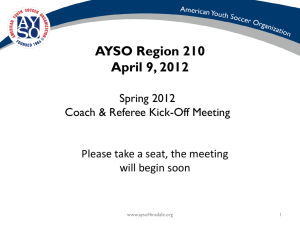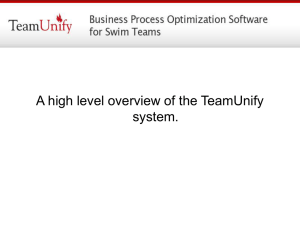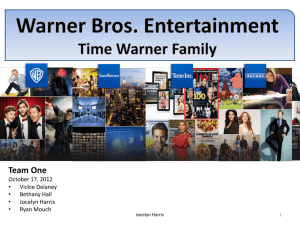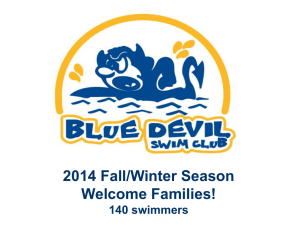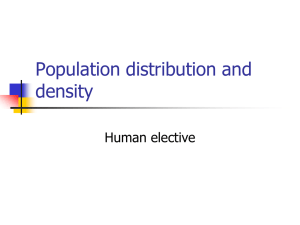if you have Powerpoint! - Rockland County Pop Warner
advertisement
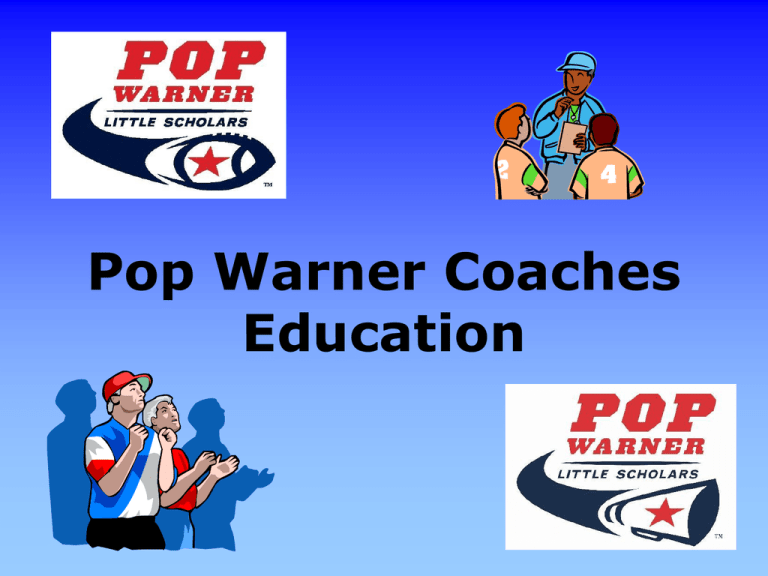
Pop Warner Coaches Education Coaches Education Training Unit 1: Clinic Introduction/PWLS Overview Unit 2: Risk Management Unit 3: Pop Warner Forms, Championships & Scholastics Unit 4: Coach-Athlete Communication Why Children Play Youth Sports Coach & Parent Behavior Coaches Code of Conduct Closing Remarks-PWLS Coaches’ Education Test First Question??? • Is this for Cheer or Football?? • It is for both. • What will now be known as “The Coaches Education Training” is for all Administrators, Commissioners, Coordinators, Head Coaches, Assistant Coaches, and anyone else working with your children in Pop Warner today. – Consistent training between coaches and commissioners – Coaches are responsible for managing the team/squad – Commissioners are responsible for administrating the game and rules. – EVERYONE is responsible for following the rules! UNIT ONE: POP WARNER OVERVIEW Unit 1: Pop Warner Overview • Brief History of Pop Warner • Goals/Philosophy • Pop Warner Structure – National, Regional, League, & Association • • • • Authority/Powers of the Region Authority/Powers of the League Association Responsibilities Protests/Complaints Pop Warner is… • The largest and oldest national youth football and cheerleading program. • Endorsed by the NFL and the NFL Players Association. • The only youth sports program to emphasize education. • Pop Warner DEMANDS THAT ALL PARTICIPANTS BE ACADEMICALLY FIT AS WELL AS PHYSICALLY FIT. – Pop Warner recognizes and awards scholar-athletes for their performance in the classroom. – Awards include scholarships to the top award winners. POP WARNER HISTORY • FROM THE BEGINNING, THE PROGRAM WAS BASED ON A RELATIONSHIP BETWEEN SCHOLASTICS AND ATHLETICS. POP WARNER HISTORY • GLEN SCOBIE (POP) WARNER, FAMED COLLEGE COACH OF THE 1920’S, GAVE PERMISSION FOR THE PROGRAM TO BE NAMED AFTER HIM. THIS OCCURRED AFTER HE WAS THE ONLY COACH INVITED TO TEACH A CLINIC THAT ACTUALLY SHOWED UP. NATIONAL & INTERNATIONAL POP WARNER • NATIONAL HEADQUARTERS – Langhorne, PA. • WORLD WIDE PARTICIPATION – United States Russia – Guam Germany – Japan Canada – Mexico Scotland OVER 370,000 REGISTERED PARTICIPANTS. PWLS GOALS & PHILOSOPHY • Academics and athletics go hand in hand. • Development of well rounded young men and women. • Teach fundamentals of Football and Cheerleading. • Stress the importance of Education. GOALS & PHILOSOPHY • Provide an atmosphere conducive to development of sound mind, body, and character. • Stresses the importance of making this a fun experience. GENERAL OBJECTIVES • Inspire youth regardless of race, creed, religion or national origin. • Practice ideals of fellowship, sportsmanship, scholastics,and physical fitness. • Teach lessons of value in selfdiscipline, teamwork, concentration, friendship, leadership, and sportsmanship. GENERAL OBJECTIVES • Provide all an opportunity to participate in an organized environment that places emphasis on maximum safety and participation. • Provide a safe environment that is structured of all participants. POP WARNER STRUCTURE • National Pop Warner • Regional Pop Warner (example: Eastern) • League/Conference (example: Rockland County) • Association (example: Suffern) • Team (Division Pee Wee) Pop Warner Little Scholars National Staff Jon Butler Executive Director Mary Fitzgerald COO Sam Mutz Football Commissioner Beth Dietz Events Coordinator Lisa Moroski Cheer/Dance Commissioner Phyllis Farruggio Office Manager Josh Pruce Scholastics Director Trevor Scholl Recruiting and Marketing Pop Warner Little Scholars Eight Regions National Pop Warner New England Eastern Mid-America Southwest Mid-South Southeast Wescon Pacific Northwest National Authority • Pop Warner Little Scholars, Inc. (PWLS) – – – – – Parent Organization Provide the National structure for the organization PWLS has final authority over all rule changes Administer the All-American Scholastic Program. Operate the National Championships for Football, Cheer and Dance. – License vendors for Pop Warner logo merchandise Eastern Region Management Team Structure Larry Hahn Tom LeCompte Tom Barone Debby Marshall Jack Fuller Neville Clothier Mike Parrow Dave Sanders Vendor Liaison Sgt-At-Arms Treasurer Cheer Commissioner Secretary Challenger Division Bowl Game Commissioner Dave Marshall Region Director Communications FOOTBALL COMMITTEE Bill Lynch James McDaniel Boyd Woodhams Craig Karahuta John Wells Jim Misiaszek Harry Harrington Cindy Machan Avie Sanders Vice Region Director CHEER COMMITTEE RCDC Scholastics Coordinator Neville Clothier Lisa Dupell Kerry Lorenca Michelle Keller Janet Wojcik Melissa Westcott Peggy Custode REGION AUTHORITY • The Region is an extension of Pop Warner Little Scholars. • Oversees the business/operation of the Region. • Enforces policies. • Conducts hearings and accepts appeals. • Disciplines when necessary. • Certifies teams for National competition. League (Conference) Structure League Board President, Commissioner, Spirit Coor. Scholastic Coor. Secretary, Treasurer, etc. Association 1 Association 2 Association 3 Association Etc. (Association Board) (Association Board) (Association Board) (Association Board) Midget Midget Midget Midget Jr. Midget Jr. Midget Jr. Midget Jr. Midget PeeWee PeeWee PeeWee PeeWee Jr. PeeWee Jr. PeeWee Jr. PeeWee Jr. PeeWee Mitey Mite Mitey Mite Mitey Mite Mitey Mite Tiny Mite Tiny Mite Tiny Mite Tiny Mite Flag Flag Flag Flag Rockland County Pop Warner Board of Directors Frank Pipolo President Pierre Davis Vice President Bill Cade Commissioner Helen Rendos Cheerleading Director Jean Turco Treasurer Donna Principe Secretary Ralph Tana Director Communications Larry Alston Director Mitey-Mites Bob DeRosa Director Flag Adam Gullo Director, JR PW 21 LEAGUE POWERS & AUTHORITY • • • • • • • Enforce National & Local rules. Establish Association Boundaries. Select Membership. Training of it’s members. Police powers/hearings & appeals. Discipline members (adult & juvenile). Summary Dismissal Authority Association / Neighborhood Program *FOOTBALL *CHEER/DANCE *SCHOLASTICS Rockland County Pop Warner Associations 10 Associations • • • • • • • • • • New Jersey Giant Eastchester Blue Devils Monroe Crusaders New City Rams New Rochelle North Rockland Red Raiders Orangetown Patriots Ramapo/Spring Valley Hornets Suffern Midget Mounties Valley Cottage Indians 24 ASSOCIATION BOARD • Personnel should include – President – Vice President – Secretary – Treasurer – Football Commissioner – Cheerleading Coordinator – Scholastic Coordinator (Minimum) ASSOCIATION BOARD • Personnel may also include: – Registrar – Fund Raising Chairman – Concession Stand Manager – Equipment Manager – Weigh Master • Whatever you think would help your Association run very efficiently. ASSOCIATION RESPONSIBILITIES • • • • • • • Fund raising Buy equipment Recruit coaches Secure field Liabilities Insurance Registration ASSOCIATION RESPONSIBILITIES • • • • • Enforce National & Local rules. Write & Maintain Association by-laws Keep Financial Records & Accounting Data Police - Boundaries/Members. Hold Hearings & Appeals. – Discipline members (adult/juvenile). – Set Grievance Procedures • Work together enforcing league policy and rules. ASSOCIATION KEYS TO SUCCESS • The representatives of your association should attend a monthly meeting to receive information so that your association will be well informed and prepared for your season of football and cheer/dance. • Failure by your representatives to attend will create an uninformed association. ASSOCIATION KEYS TO SUCCESS • Background Checks: Some type of background check will be done on all volunteers and administrative personnel. • Discretion should be top priority on information received. • One affidavit per association should be forwarded to the League. • League to National. Importance of Background Checks • Sports Illustrated article from Sept., 1999 • http://sportsillustrated.cnn.com/features/cover/news/2000/04/14/nack_nightmare/coverlarge.html KEYS TO SUCCESS • To be a successful league and association it is important that your league and your association work hand in hand with open communications and a clear direction. • It is imperative that your board accept responsibilities when it comes to informing your coaches and members, plus discipline when needed. • Please ask questions if you do not understand. The Squad • Squad Staff – Association Cheer Coordinator – Head Coach – Assistant Coaches – Coach Trainee – Team Parent – Equipment Manager – Jr. Trainer – Student Demonstrators Squad Staff • A total of nine (9) staff positions – 1 Head Coach (21 or older) and 4 Assistant Coaches (18 or older) • Ratio of children to coaches (12:1) at all events (practice, game, competition) – Maximum of 3 Coach-Trainees (16 – 17 years of age) and a maximum of 4 Student Demonstrators (15 – 17 years of age) • Maximum of 4 Student Demonstrators and Coach Trainees Combined. 34 Coach-Trainees and Student Demonstrators • Certified like a spirit participant (BC, physical, parental approval, scholastic fitness, etc.) • Must be at least 2 years older than the oldest child on the squad • Must have at least 2 years of prior Cheer/Dance experience. • Student Demonstrators Demonstrate! No hands-on coaching, may only demonstrate moves and teach words to cheers. 35 Formation of Squads • Squad structure – Small squad (6 – 20) – Large squad (21 – 35) • Up to 3 squads for each football team may exist 36 Squad without Football Team • Any cheer or dance squad w/o football team – Must be age eligible – Must be associated with ONE football team (different level) and participate at game weekly – May compete League/Region/National – May be large or small 37 Team Authority • Enforce National, Regional & Local rules and procedures. • Train Participants • Discipline Participants (Limited Authority). COACHES COMMITMENT • It is the Volunteer’s responsibility to support the goals and philosophy of the Pop Warner program. Please work with your local associations in supporting and making your League and National Pop Warner the best youth program in the country. PROTESTS/COMPLAINTS • Only Protests involving the eligibility of a participant shall be considered. • Complaints or Grievances may be filed on all other concerns that may arise during the season. • Both protests and complaints must be filed in a timely fashion. UNIT 2: RISK MANAGEMENT RISK MANAGEMENT DEFINITION • Directing or controlling the interests and performance of your program by teaching, guiding, and inspiring others to provide a safe and healthy experience for its participants. Risk Management • Lawsuits are more and more common. • How many newspaper stories have appeared lately regarding lawsuits and youth sports? Risk Management • "Father sues team for not naming son MVP" AP/ESPN, Nov. 7, 2002 "A Canadian father is suing the Amateur Hockey Association after his 16-year-old son failed to win the league's most valuable player award. The dad is seeking about $200,000 in psychological and punitive damages from the association. He also demands that the MVP trophy be taken from the winner and given to his son. • "Parents suing youth football league". Houston Chronicle, August 28 -Texas: "Parents of a fifth-grade boy asked the courts Tuesday to throw a yellow penalty flag on the Youth Football league over a rule change…. that switched players to different teams after practice started. In a lawsuit filed Tuesday, an attorney sued the Youth Football league on behalf of his son. The boy had played with his grade-level team before being switched because of age to a junior high-level group with "significantly larger" players. The parents are asking a judge to order the league to revert to rules in place when children registered in May." (Jo Ann Zuniga, Aug. 20). Risk Management • “Settlement ends paralyzed boy's lawsuit: $2 million deal reached over soccer field injury” “A Waukesha, Wisconsin County Circuit Judge ordered the approval of the settlement between the parents of an 11-yearold youth soccer player, and the insurance companies…” “The top bar of a goalpost tipped over and struck the boy on the head and shoulders when his teammates … were attempting to move the soccer goal by pushing it from behind.” By Linda Spice, Journal Sentinel staff, Last Updated: Nov. 24, 1999 Risk Management • “Losing Season Prompts Dad to Sue Son's Coach." This is NOT a joke. After a dismal season, a baseball coach was sued in small-claims court for being a lousy coach. The father of the 16-year-old catcher demanded $2,000, "the estimated value of a seven-day Florida trip the team could have made, had it not lost every game. Most by a 10-run mercy rule." He claimed the team played so poorly that his son lost out. Source: “Parents take sportsmanship out of kids' sports " Jewish World Review Dr. Laura, March 1, 2000 /24 Adar I, 5760 ----------------------------------------------------------------------------------------------- • “Lawsuit Clouds Play At PONY Tournament” Sports Headline from the Tampa Tribune Published on August 5, 2003 RISK MANAGEMENT • The majority of litigation dealing with coaches involves negligence. • Negligence: Defined as the failure to use reasonable and prudent care in a situation that may cause harm to someone or something. Risk Management • IN THE SUPREME COURT OF CALIFORNIA 8/28/03 Plaintiff vs - EAST SIDE UNION HIGH SCHOOL “Coaches could be legally liable for injuries sustained by young athletes under their control, …” Reported by DAVID KRAVETS, AP Legal Affairs Writer RISK MANAGEMENT One key component of being a responsible coach is to learn the Pop Warner rules and the expectations set by your local board. • Official Rule Book: Know and understand the rules of Pop Warner. • League Rules & Procedures: Make sure that you understand your responsibilities and that you carry out the expectations of your board. TOP DUTIES OF A COACH B. C. D. E. F. G. H. I. J. Properly plan the activity. Provide appropriate supervision. Provide proper instruction. Provide adequate and safe equipment. Evaluate for injury or incapacity. Provide safe physical environment. Match athletes appropriately Warn of inherent dangers Initiate medical response. B-Properly plan the activity • Plans must be reasonable, well thought out, based on past experience with the athletes’ readiness in mind. • All plans should be reviewed continuously and kept for the record. • Finally, plans should contain properly written performance objectives and documented logical sequences and progression for learning the skill. RISK MANAGEMENT • As a coach, it is your responsibility to plan your practices. “A cup of quality outweighs a quart of quantity” • Complete a Practice Plan Form, which should include the activity and skills that will be reviewed and talked about during your practice sessions. • Identify the amount of minutes you will spend on each activity and skill. • At the start and end of each practice, evaluate and make comments on your Practice Plan Form. • Identifying any injuries or major concerns. Risk Management We don’t plan to fail; We fail to plan. Warm-up and Cool down • A proper warm-up and cool-down helps athletes train and compete without being injured. • Guidelines for Warm-up/Cool down • Guidelines for Warm-up/Cool down are found in the Pop Warner Coaches Risk Management Manual as well as the Pop Warner Rule Book. They include – – Minimum 10 minute warm-up before and 10 minute cool down after practices and games – No more than 30 minutes of warm-up before games and competitions TRAINING Training methods and type, frequency, duration, and intensity of practices should vary among athletes, depending on the athlete’s age, physical conditioning, mental state, and training goals. The purpose of training is to prepare for competition. Training is not to be used as a disciplinary activity, unsupervised play, or competition itself. Guidelines for Training – 1. Recommend that training begin before the season starts so athletes are in good condition for the first day of practice. Injuries are more likely when poorly conditioned athletes over-train early in the season. 2. Pay attention to ensure that training balances fitness and skill development in all training sessions. 3. Ensure that training intensity increases gradually. 4. Teach athletes to be aware of their training levels. 5. Note athletes to be aware of their training levels. 6. In warmer, more humid climates, modify training to prevent heat-related emergencies. Guidelines for Training – 7. Coaches should insure sufficient water breaks and encourage the athletes to drink water. 8. If supplied by the team/squad or by the practice facility, the water should be healthful and potable. 9. Water delivery systems should be designed to prevent the spread of any infection and/or contagious disease. C-PROVIDE APPROPRIATE SUPERVISION • General supervision is the oversight of all area and events taking place during the session, whether training or competition. • Specific supervision is the oversight of specific elements or skills being performed. • Coaches should avoid any situation where a single coach is alone with one or more minors (always have 2 or more coaches) Risk Management Never be alone with an athlete or let a colleague be alone with an athlete: Example from the headlines: Soccer clubs, coaches sued over sexual abuse of girl “The parents of a girl who was sexually abused by her soccer coach in 2003 are suing the former coach, three local soccer clubs and three other coaches for negligence.” ARIZONA DAILY STAR Published 4/7/2005 D-Provide Proper Instruction •Follow the accepted practices for teaching sport specific. •Follow the drills and other methods that are considered standard for the sport. •Maintain familiarity with trends in the sport. •Provide instructions that focus on the more hazardous areas of a particular sport and/or techniques that are counterintuitive such as certain blocking/tackling techniques and stunts. •Be familiar with the venue surroundings and instruct athletes to do the same. •Maintain records of instruction and training. Provide Proper Instruction 1. Introduce the Skill Athletes, especially young and inexperienced ones, need to understand what skill they are learning and why it is important. Coaches should take the following steps into consideration when teaching a new skill: -Ensure that you have the athlete’s attention. -Name the new skill. -Explain the importance of the skill in detail Provide Proper Instruction 2. Demonstrate the Skill The demonstration step is the most important part of teaching the skill to young athletes since they often have never done anything similar to it. They need to see how the skill is properly performed. If you are unable to perform the skill correctly, have an assistant coach or someone skilled perform the demonstration. Your demonstrations will be more effective if you: -Use correct form. -Demonstrate the skill several times. -Slow down the skill, if possible, during one or two performances so athletes can see every movement involved. -Demonstrate the skill from both the left and right sides, as well as from different angles. Provide Proper Instruction 3. Explain the Skill Athletes are able to comprehend more complex skills when they are broken down and explained in more manageable parts. Coaches should break down new skills into the following parts: -Show athletes the entire skill correctly and explain the function in the sport. -Break down the skill and point out its component parts to the team. -Require the athletes to perform each of the component skills. -Re-explain the entire skill, after the athletes have demonstrated their ability to perform the separate parts of the skill in sequence. -Have athletes practice the skill. Provide Proper Instruction 4. Pay Attention to Athletes Practicing the Skill Some athletes may need to be physically guided through the movements during their first few attempts. Once your athletes have demonstrated that they understand how to perform the skill, a significant part of coaching will involve closely observing the performances of your athletes. As you observe athletes’ efforts in practices and competitions, it is important to: -Point out what the athlete did correctly. -Let the athlete know what was done incorrectly and provide instruction on how to correct it. -Offer positive, corrective feedback. -Document progression. RISK MANAGEMENT • The number one law suit for youth sports is teaching improper technique. • As a coach it is your responsibility to improve your coaching skills by taking classes, reading books, going to clinics, or reviewing tapes that will allow you to give proper instructions on technique. • As a coach, do not attempt to teach skills that YOU DO NOT know or understand. E- Provide Adequate and Safe Equipment • Equipment should be fitted properly. • Inspected daily and maintained at all times. SAFE EQUIPMENT The coach is responsible for: • Determining what equipment will be used in training and competing. • Selecting appropriate equipment. • Making the equipment available. • Overseeing the use of equipment. • Knowing the procedures for inspecting athletes’ equipment. Never modify equipment! F- Evaluate for Injury and Incapacity • Coaches have a duty to evaluate the physical fitness, the mental condition and the skill level of athletes. • Coaches must be able to accurately identify other conditions that must be attended to in a timely manner. • Forcing athletes to participate is not an acceptable behavior. EVALUATE • Prevention: Coaches should incorporate methods for preventing injuries in their coaching programs including pre-participation screening, strength training, conditioning and awareness of the nature, cause, and mechanisms of sport specific injuries. • Recognition and Treatment: Once the coach realizes that an injury has occurred, the magnitude must be assessed and appropriate care initiated. G- Provide Safe Physical Environment • Inspection of a practice or competition facility for safety hazards is the responsibility of the coach. Therefore, facilities need to be inspected daily before permitting your athletes to participate in practices or contests. • Field Preparation: Check the condition of field, Look for pending Dangers, Proper identification of restricted areas, Security provided when appropriate. Report any unsafe conditions Transportation Transportation of Participants: • Proper transportation of participants is a must. • Adult licensed individual. • Vehicles should have seat belts, no open pick-up trucks. • Vehicles should be in proper working order (good/safe condition). RISK MANAGEMENT LIGHTNING AND WEATHER INCLEMENT WEATHER • Monitoring weather condition is the responsibility of the game official, Coaches, Association and League administrators. • Discuss the procedures you will follow if inclement weather becomes a issue. RISK MANAGEMENT • In the continental United States 1000 people are hit by lightning each year. One hundred of those are fatalities. • Take precautionary measures if lightning is approaching your practice area or game site. • Safety is the number one priority. H – Match Athletes Appropriately • Coaches must be sure their participants are not at a serious disadvantage by improperly matching them for practices or competition. • Skill, experience, height, weight, age, injuries, maturity, mental state and gender ALL must be considered in matching participants. I- Warn of Inherent Risks • Coaches must warn athletes of the risks of the skill, drill, or game. • Participants need to be informed of the risks in using improper, dangerous and unethical techniques. Inherent Risks • Meet with the parents of your athletes and explain the Dangers of Playing Football and Cheer/Dance. • Review “Article 6” in Pop Warner Book. RISK MANAGEMENT Article 6 • Football participants or Cheerleaders – – – – – – – Informed Parental consent Medical examination Proof of age Scholastic ID card with picture Waivers Accurate/Completed official rosters • All in a TEAM I.D. book. With you at all times PARENT ORIENTATION • Parents’ Meeting – Proposed Agenda: 1-Meet the coaching staff. 2-Talk about team mission. 3-Objectives and Goals for season. 4-Expectation of Team/ Squad. 5-Expectation of Parents 6-Logistics 7-Team Functioning 8-Question and Answer period J- INITIATE MEDICAL RESPONSE • • • • • Provide Appropriate Emergency Assistance. Check the scene for safety. Check the injured athlete and protect from further harm, following universal precautions when appropriate. DO NOT MOVE THE ATHLETE Activate your “Emergency Action Plan” Care for the injured athlete until EMS Arrive INITIATE MEDICAL RESPONSE • Plan: Work together with your local EMT’s to establish an Emergency Action Plan that will fit your specific area and needs. • Plan should include informing visiting team of medical staff available, emergency numbers, directions to emergency medical facilities. • Have someone identified as a contact person at the home field. RISK MANAGEMENT • Mandated insurance: Is required for all associations who are members of Pop Warner. This will provide protection for practice fields, game fields, fund raisings, volunteers and drivers. • Coaches Training: All coaches MUST be trained through the Little Scholars training Program. RISK MANAGEMENT • Warm Weather Precautions: – Discipline of participants – Scheduling of practice – Provide plenty of water – Mandatory breaks • Be aware what will cause heat cramps, heat exhaustion and heat stroke. Risk Management SUMMARY • Common Sense • Reasonable and Prudent Care • Preventive Maintenance • Do The Right Thing! BREAK TIME Unit 3: Pop Warner Forms & Championships (all available at www.popwarner.com) Forms • All American Scholar Form • Absentee Form (See National Pop Warner Site) 87 Cheer Eligibility Clarification • Participants may individually enroll in nonPop Warner affiliated instructional classes. However, a participant may not be officially enrolled in another competitive cheer or dance squad that is not a High School affiliated “winter sport” program. Junior High, Elementary, All-Star and other Recreational cheer and dance squad participation is not permitted during the Pop Warner Season. 88 UNIT 4 COACH-ATHLETE COMMUNICATION – BEING A GOOD TEACHER OF THE GAME & WHY CHILDREN PLAY YOUTH SPORTS Positive Coaching Techniques Coach-Athlete Communication Effective Communication • Get to know your participants • Communicate that you care • Let them know that they matter to you Coach-Athlete Communication Giving Effective Feedback 1. Catch athletes doing things correctly. 2. Be Specific & Concise. 3. Focus on Strengths more than Weaknesses. 4. Give feedback promptly – Immediately. 5. Be sincere when giving praise. 6. Reward Improvements – Not Perfection. 7. Reward Effort as well as Outcome. 8. Avoid being insulting and negative. WHY CHILDREN PLAY YOUTH SPORTS AUDIENCE PARTICIPATION Activity WHY CHILDREN PLAY YOUTH SPORTS THE IMPORTANCE OF KEEPING THINGS IN PERSPECTIVE WHY CHILDREN PLAY SPORTS SURVEY SAYS… TOP 5 REASONS WHY YOUTH SAY THAT THEY PLAY SPORTS ****************************************** 1. Have FUN!!! 2. Be on Team – Be with Friends 3. Learn New Skills 4. The Excitement of Competition 5. Get in Shape WHY CHILDREN PLAY SPORTS Top 5 Reasons Why Youth Drop Out of Sports 1. 2. 3. 4. Lost interest (boring.) I was not having fun. It took too much time. Coach was a poor teacher (always hollering.) 5. Too much pressure (worrying about the coach getting mad.) WHY CHILDREN PLAY SPORTS How to Keep Young Athletes Involved in Football & Cheerleading 1. 2. 3. 4. 5. Emphasize Learning New Skills and Improving Existing Ones. Have Fun. Maintain a Safe Environment. Challenge Athletes with Physical Exercises in a Creative Way. Give participants a Sense of Belonging to a Team THE CONCERN Pop Warner has been increasingly concerned about the numbers of incidents of parental violence and misbehavior of coaches. As a member it is your responsibility to change this trend and harness the energy for a more positive result. Coach & Parent Behavior • The news papers and TV are full of stories about youth coaches and parents ruining youth sports for the kids. COACH/PARENTAL BEHAVIOR What about the parent who: • Uses Verbal Abuse • Attempts to Intimidate • Is Flagrantly Rude • Cannot Control Their Language or Actions Should This Individual Be Removed From Pop Warner? What if it was a… (A Board Member, Coach, Football Player, or Cheerleader) COACH/PARENTAL BEHAVIOR • Does a coach have the right to be belligerent? • Does a winning coach have the right to be treated differently than a coach who does not have a good season? • If a coach physically abuses an official, administrator, or any Pop Warner volunteer, what should happen to him/her? COACH/PARENTAL BEHAVIOR • As a Coach it is your responsibility to control these types of behaviors. • Your League, as the governing body, will assist your Association in dealing with problem behaviors and disruptive individuals . • Your League, along with your Association, MUST have a zero tolerance for aggressive, disruptive, and disrespectful behavior. COACHES BEHAVIOR Leadership • Lead by example. • To be a good leader, you must be a good follower. COACHES BEHAVIOR • • • • • • • • • • MANDATED PENALTIES ADULT OFFENSES Run-up Score Endangerment of Juveniles Teaching Prohibited Techniques Fighting/Cheating/Threatening/Gambling Lack of Cooperation/Obstruction Violation of Mandatory Play Falsification of Official Documentation Alcohol Illegal Practices Negative Attitude Unit 9 PWLS Coaches Code of Conduct Code of Conduct • S1: Not smoke and or use smokeless tobacco on the field. Code of Conduct • S2: Not criticize players/cheerleaders in front of spectators, but reserve constructive criticism for later, in private, or in the presence of team/squad members if others might benefit. Code of Conduct • S3: Accept decisions of the game officials and judges on the field and in competitions as being fair and called to the best ability of said officials. Code of Conduct • S4: Not criticize an opposing team, its participants, coaches, cheerleaders or fans by word of mouth or by gesture. Code of Conduct • S5: Emphasize that good athletes strive to be good students and that both are physically and mentally alert. Code of Conduct • S6: Strive to make every football/ cheerleading activity serve as a training ground for life, and a basis for good mental and physical health. Code of Conduct • S7: Emphasize that winning is the result of good “teamwork.” Code of Conduct • S8: Not engage in excessive sideline coaching and shall not leave the bench area to shout instructions from the sideline. Code of Conduct • S9: Together with team officials, be jointly responsible for the conduct and control of team fans and spectators. Any fan who becomes a nuisance and out of control will be asked to leave. Code of Conduct • S10: Not use abusive or profane language at any time. Code of Conduct • S11: Not “pile it on;” not encourage their team to get a commanding lead and raise the score as high as it can. In these instances, every effort shall be made to let all participants play. Code of Conduct • S12: Not receive any payment, in cash or kind, for services as a coach in Pop Warner Football/Cheerleading. This includes any coach, expert, consultant or choreographer, regardless of his/her roster status. Code of Conduct • S14: Not recommend or distribute any medication, controlled or over the counter, except as specifically prescribed by participant’s physician. Code of Conduct • S15: Not permit an ineligible player to participate in a game. Code of Conduct • S16: Not deliberately incite unsportsmanlike conduct. Code of Conduct • S17: Abstain from the possession and drinking of alcoholic beverages and the possession or use of any illegal substance on both the game and practice fields. Code of Conduct • S18: Remove from a game or practice any participant when even slightly in doubt about his/her health, whether or not as a result of injury, until competent medical advice is available. Code of Conduct • S19: Control their fans. Remember, as a team coach, you’re responsible for your team, and fan reaction will usually be in step with your reaction. Code of Conduct • S20: Uphold all rules and regulations, national and local, regarding Pop Warner Football, Cheerleading, and Dance. Code of Conduct • S21: Refrain from engaging in any action which reflects negatively, or causes embarrassment to the PW Program.
